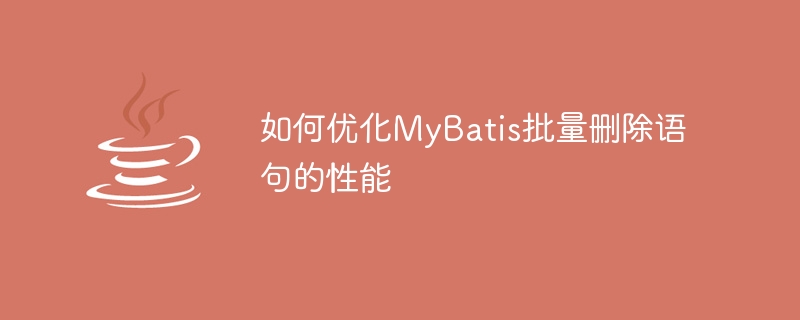Home >Java >javaTutorial >Improve the efficiency of MyBatis batch deletion operations
Improve the efficiency of MyBatis batch deletion operations
- WBOYWBOYWBOYWBOYWBOYWBOYWBOYWBOYWBOYWBOYWBOYWBOYWBOriginal
- 2024-02-18 10:18:061294browse

How to optimize the performance of MyBatis batch delete statements
MyBatis is a commonly used Java persistence layer framework, which provides great convenience for accessing relational databases. In actual development, we often encounter scenarios where we need to delete data in batches. How to optimize the performance of MyBatis batch delete statements is an issue that requires focus. This article will introduce some optimization techniques and provide specific code examples.
- Using the foreach tag
In MyBatis, you can use the foreach tag to traverse the collection and pass the elements in the collection as parameters into the SQL statement to implement batch operations. When deleting data in batches, you can use the foreach tag to pass the data to be deleted as parameters into the SQL statement to avoid executing the SQL statement multiple times.
The sample code is as follows:
<delete id="batchDelete" parameterType="java.util.List">
DELETE FROM table_name
WHERE id IN
<foreach collection="list" item="id" open="(" separator="," close=")">
#{id}
</foreach>
</delete>- Using dynamic SQL
Dynamic SQL is a powerful feature in MyBatis, which can flexibly construct SQL statements based on conditions. When deleting data in batches, you can use dynamic SQL to dynamically generate deletion conditions to reduce unnecessary deletion operations.
The sample code is as follows:
<delete id="batchDelete" parameterType="java.util.Map">
DELETE FROM table_name
WHERE 1=1
<if test="ids != null and ids.size() > 0">
AND id IN
<foreach collection="ids" item="id" open="(" separator="," close=")">
#{id}
</foreach>
</if>
<if test="param1 != null and param1 != ''">
AND column1 = #{param1}
</if>
<if test="param2 != null and param2 != ''">
AND column2 = #{param2}
</if>
</delete>- Delete in batches
If the amount of data to be deleted is very large, one-time deletion may cause memory overflow or database performance decline. At this time, you can consider performing the deletion operation in batches to avoid deleting a large amount of data at once.
The sample code is as follows:
public void batchDelete(List<Integer> ids, int batchSize) {
int totalSize = ids.size();
int batchCount = totalSize / batchSize;
for (int i = 0; i < batchCount; i++) {
List<Integer> batchList = ids.subList(i * batchSize, (i + 1) * batchSize);
mapper.batchDelete(batchList);
}
if (totalSize % batchSize != 0) {
List<Integer> batchList = ids.subList(batchCount * batchSize, totalSize);
mapper.batchDelete(batchList);
}
}- Using batch processing
MyBatis provides batch processing operations, which can send multiple SQL statements to the database for execution at one time. When deleting data in batches, you can use batch operations to improve deletion efficiency.
The sample code is as follows:
public void batchDelete(List<Integer> ids) {
sqlSession.getConnection().setAutoCommit(false);
try {
for (Integer id : ids) {
mapper.delete(id);
}
sqlSession.commit();
} catch (Exception e) {
sqlSession.rollback();
} finally {
sqlSession.getConnection().setAutoCommit(true);
}
}Summary:
By using optimization methods such as foreach tags, dynamic SQL, batch deletion and batch processing, it can be effectively improved Performance of MyBatis batch delete statements. In actual applications, appropriate optimization methods are selected according to specific business scenarios to achieve better deletion performance.
The above is the detailed content of Improve the efficiency of MyBatis batch deletion operations. For more information, please follow other related articles on the PHP Chinese website!

